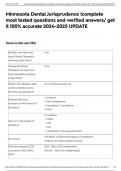Biology Nikhil 13Y Topic 5 Full Notes
TOPIC 5 – On The Wild Side
Definitions:
ECOSYSTEM: All the organisms living in a particular area, and all the abiotic
factors.
HABITAT: The place where an organism lives.
POPULATION: All the organisms of an individual species in a particular area.
COMMUNITY: All the organisms of all species that live within the same
habitat and interact with one another.
BIOTIC FACTORS: The living features of an ecosystem.
ABIOTIC FACTORS: The non-living features of an ecosystem.
ABUNDANCE: The number of individuals of an individual species in a
particular area.
DISTRIBUTION: The whereabouts of a species in a particular area.
Abiotic Factors:
TEMPERATURE: The surrounding climate/temperature of an organism’s
habitat.
If temperature is not optimal, more energy is used for maintaining core
body temperature and more energy is required for enzyme reactions to
occur in organisms.
WATER AVAILABILITY: The availability of water sources.
Rain Gauge
LIGHT AVAILABILITY: The amount of sunlight available.
Lux meter
SLOPE & ASPECT: The altitude, incline and the direction of facing. North
Facing = Less Sunlight, South Facing = More Sunlight.
Distribution of namely vegetation is affected by aspect, as south-facing
slopes will see the highest concentration compared to other aspects.
Clinometer for Steepness
Compass for Aspect
OXYGEN CONCENTRATION: Amount of oxygen available in the
surroundings, needed for respiration.
Oxygen Sensor
SOIL pH & MOISTURE: The acidity and moisture of a plant’s soil is indicative
of its growth.
Some vegetation does not grow near shores, as the soil has a high
salinity.
pH/Moisture Probe
POLLUTION: Any pollution may harm or limit the growth of an organism.
NATURAL DISASTERS: Large events can cause the wipeout of a population.
, Biology Nikhil 13Y Topic 5 Full Notes
Biotic Factors:
COMPETITON: This occurs for mates and resources such as food, light,
water, and space. It occurs intra and inter specifically.
Intraspecific competition may form a fluctuation in the abundance of a
population. This is because as resources are plentiful, the population
grows successfully. But as it grows, so does intraspecific competition,
therefore the abundance falls again. The equilibrium is called the
carrying capacity.
Competition gives way to adaptation and natural selection. A better
adapted species will be able to survive and out-compete other species
for the resource.
Every species has its own unique niche.
If more than one species occupies a niche, then there will be
competition, meaning the abundance of each species will be affected.
PREDATION: The presence of predators is a threat to the abundance of a
population. This can also be a human inflict.
Predation is positively correlated to the abundance of the prey. As the
availability of prey is plentiful, the abundance of predators rises, but as
the prey becomes scarce due to competition, the population of prey
and thus predators, falls.
DISEASE & INFECTION: A break out of a disease can jeopardise the
abundance of a population. This can also have a secondary effect on the
predators and prey of the organism.
Sampling Techniques:
To keep results reliable and valid, bias should be avoided whilst investigating.
As a result, random sampling techniques should be used:
Divide your sample area into a grid using a belt or line transect and
tape measures, and use a random number generator to choose places
to sample using a quadrat.
Alternatively, sometimes systematic sampling should be used, for example,
when investigating abiotic factors.
This involves taking samples at a given interval.
Investigating Populations of Organisms:
ABUNDANCE
The number of individuals in a sampling area can be counted.
Alternatively, percentage cover of motionless organisms/plants, can be
determined using a frame quadrat.
This involves calculating the percentage area that the species occupies
with respects to the sample space.













